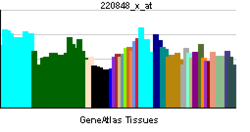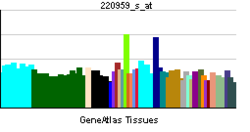- OBP2A
-
Odorant binding protein 2A Identifiers Symbols OBP2A; OBP; OBP2C; OBPIIa; hOBPIIa External IDs OMIM: 164320 MGI: 2387617 HomoloGene: 105715 GeneCards: OBP2A Gene Gene Ontology Molecular function • transporter activity
• odorant bindingCellular component • cellular_component
• extracellular regionBiological process • sensory perception of chemical stimulus
• sensory perception of smell
• response to stimulusSources: Amigo / QuickGO RNA expression pattern 

More reference expression data Orthologs Species Human Mouse Entrez 29991 383678 Ensembl ENSG00000122136 ENSMUSG00000079539 UniProt Q9NY56 Q8K1H9 RefSeq (mRNA) NM_014582 NM_001099301.1 RefSeq (protein) NP_055397 NP_001092771.1 Location (UCSC) Chr 9:
138.44 – 138.44 MbChr 2:
25.59 – 25.6 MbPubMed search [1] [2] Odorant-binding protein 2a is a protein that in humans is encoded by the OBP2A gene.[1]
This gene encodes a small extracellular protein belonging to the lipocalin superfamily. The protein is thought to transport small, hydrophobic, volatile molecules or odorants through the nasal mucus to olfactory receptors, and may also function as a scavenger of highly concentrated or toxic odors. The protein is expressed as a monomer in the nasal mucus, and can bind diverse types of odorants with a higher affinity for aldehydes and fatty acids. This gene and a highly similar family member are located in a cluster of lipocalin genes on chromosome 9. Alternatively spliced transcript variants have been described, but their biological validity has not been determined.[1]
References
Further reading
- Tegoni M, Pelosi P, Vincent F, et al. (2000). "Mammalian odorant binding proteins.". Biochim. Biophys. Acta 1482 (1–2): 229–40. doi:10.1016/S0167-4838(00)00167-9. PMID 11058764.
- Tcatchoff L, Nespoulous C, Pernollet JC, Briand L (2006). "A single lysyl residue defines the binding specificity of a human odorant-binding protein for aldehydes". FEBS Lett. 580 (8): 2102–8. doi:10.1016/j.febslet.2006.03.017. PMID 16546182.
- Breustedt DA, Schönfeld DL, Skerra A (2006). "Comparative ligand-binding analysis of ten human lipocalins". Biochim. Biophys. Acta 1764 (2): 161–73. doi:10.1016/j.bbapap.2005.12.006. PMID 16461020.
- Gerhard DS, Wagner L, Feingold EA, et al. (2004). "The Status, Quality, and Expansion of the NIH Full-Length cDNA Project: The Mammalian Gene Collection (MGC)". Genome Res. 14 (10B): 2121–7. doi:10.1101/gr.2596504. PMC 528928. PMID 15489334. http://www.pubmedcentral.nih.gov/articlerender.fcgi?tool=pmcentrez&artid=528928.
- Strausberg RL, Feingold EA, Grouse LH, et al. (2003). "Generation and initial analysis of more than 15,000 full-length human and mouse cDNA sequences". Proc. Natl. Acad. Sci. U.S.A. 99 (26): 16899–903. doi:10.1073/pnas.242603899. PMC 139241. PMID 12477932. http://www.pubmedcentral.nih.gov/articlerender.fcgi?tool=pmcentrez&artid=139241.
- Matarazzo V, Zsürger N, Guillemot JC, et al. (2003). "Porcine odorant-binding protein selectively binds to a human olfactory receptor". Chem. Senses 27 (8): 691–701. doi:10.1093/chemse/27.8.691. PMID 12379593.
- Briand L, Eloit C, Nespoulous C, et al. (2002). "Evidence of an odorant-binding protein in the human olfactory mucus: location, structural characterization, and odorant-binding properties". Biochemistry 41 (23): 7241–52. doi:10.1021/bi015916c. PMID 12044155.
- Lacazette E, Gachon AM, Pitiot G (2000). "A novel human odorant-binding protein gene family resulting from genomic duplicons at 9q34: differential expression in the oral and genital spheres". Hum. Mol. Genet. 9 (2): 289–301. doi:10.1093/hmg/9.2.289. PMID 10607840.
Categories:- Human proteins
- Chromosome 9 gene stubs
Wikimedia Foundation. 2010.
